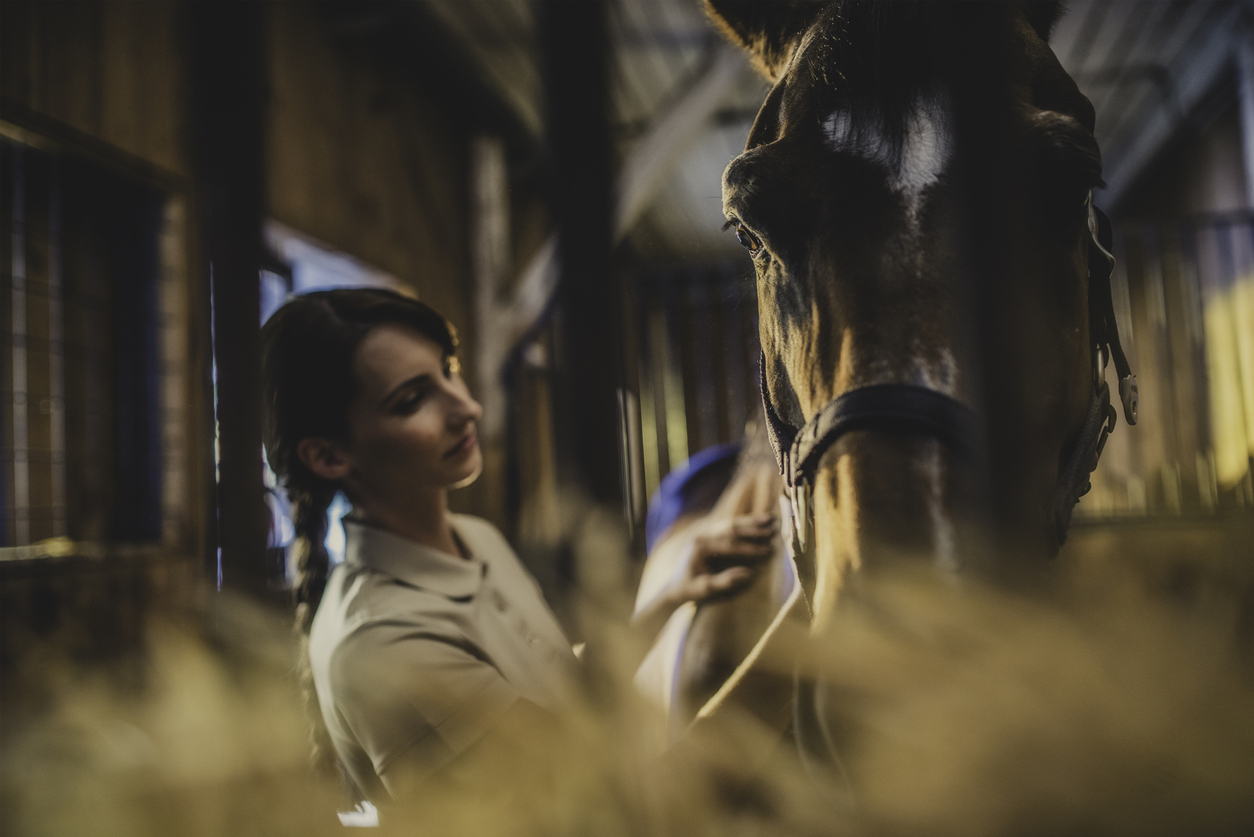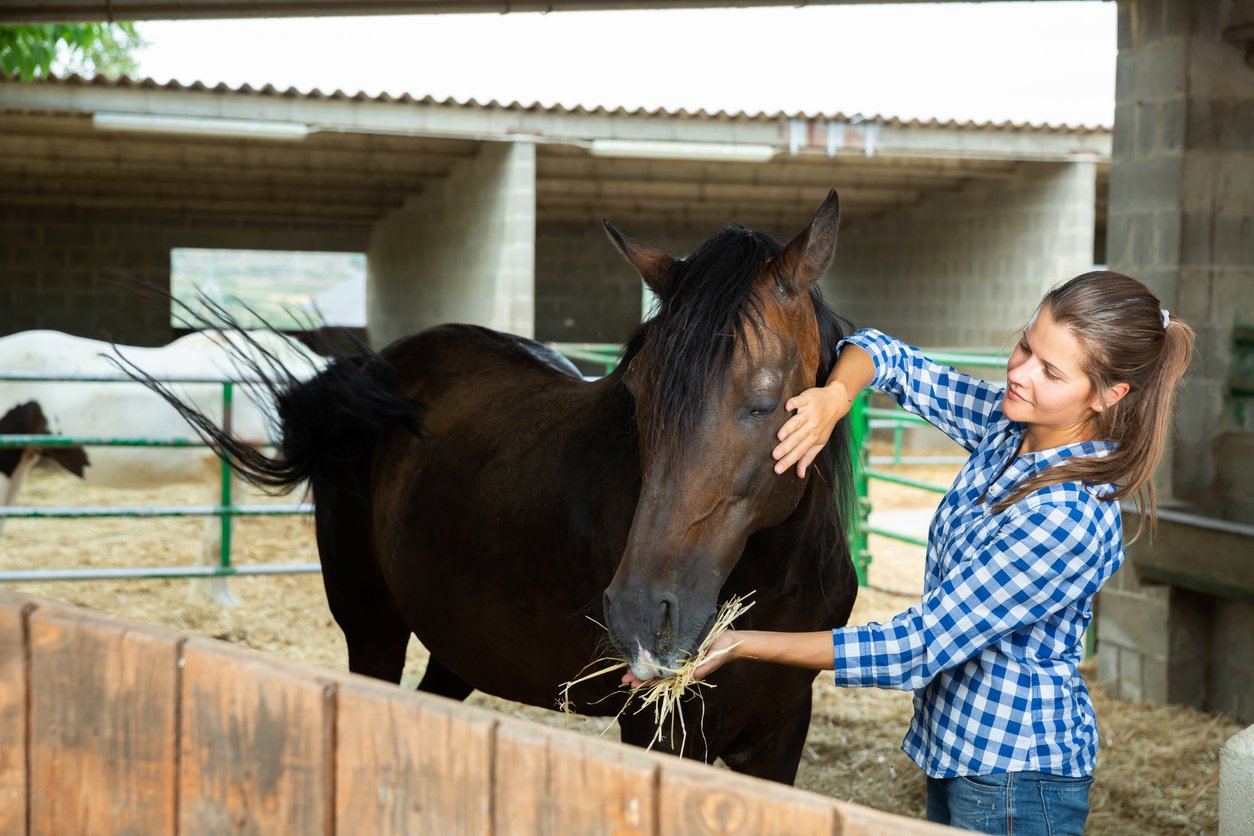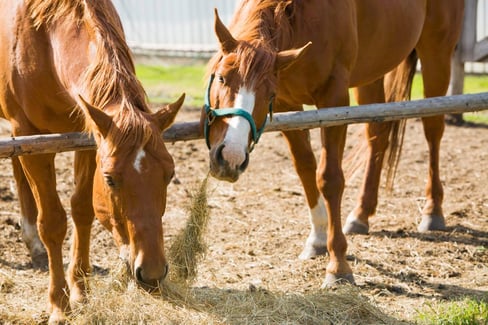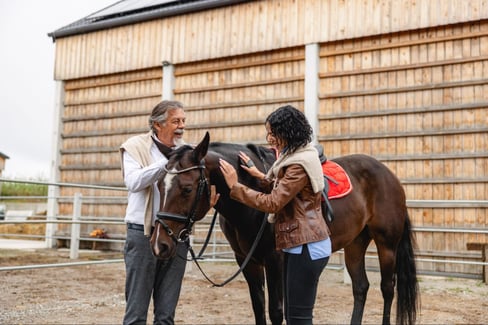Table of Contents
Picture your favourite human athlete. Whether they are a hockey player, in the NBA, or in the NFL, they use massage and stretching to prepare and recover from training and competing. Preparing the body and muscles for strenuous exercise is important, as is giving them time to relax and recover. Without this ritual, athletes can risk a lack of performance as well as serious injury due to the increased potential of muscle strain.
Given the importance of stretching and massage for human athletes, it’s no surprise that equine massage therapy is often used for performance horses. Usually, equine massage therapy is performed by a Veterinary Physiotherapist or similar professional, such as a Certified Equine Sports Massage Therapist. Professionals familiar with horse massage therapy are able to use their training and experience to work your horse’s muscles and body in a safe and effective way that helps prevent injury during performance work.
While a common therapy for sport horses, massage therapy for horses is an often overlooked procedure that can also be used for domestic or companion horses. The benefits of equine massage therapy work for all types of horses, whether it be to help them recover from an injury, treat the symptoms of a medical problem, or be a regular part of their conditioning process to prepare them for their next big event.
Horses have played an extremely important role in society for thousands of years, being essential companions for a variety of roles. Some examples include:
- Workhorses
- Racehorses, including barrel racing
- Dressage
- Eventing
- Warhorses (historical use of horses)
By incorporating massage into their regular care, we can help our equine friends to be happier and healthier throughout their lives.
In this article, we explore more about equine massage therapy, including what it is, its history, specific benefits, and how you can boost your horse’s joint health with a combination of massage therapy and horse supplements.
What Is Equine Massage Therapy?
Equine sports massage therapy is described as the therapeutic application of massage techniques to a horse’s body for the purpose of relaxing muscle spasms, increasing circulation, relieving tension and pain, enhancing muscle tone, and increasing the limbs’ range of motion.
What Does Equine Massage Therapy Do?
An Equine Sports Massage Therapist uses their hands, fingers, and elbows, alongside other tools, such as massage pads, to manipulate the soft tissues of the horse’s muscles, joints, tendons, scar tissue, and edema to increase blood circulation and lymphatic activity. This action loosens these structures in the horse’s body and reduces stress.
In other words, horse massage therapy works the soft tissues and muscles of your horse to provide improved movement and flexibility and to aid with healing if the horse has experienced an injury.
There are a variety of different equine sports massage therapy techniques which include:
- Deep tissue
- Lymphatic
- Myofascial
- Trigger point
- Scar tissue friction
- Compression
- Stretching
What Is Equine Massage Therapy Used For?
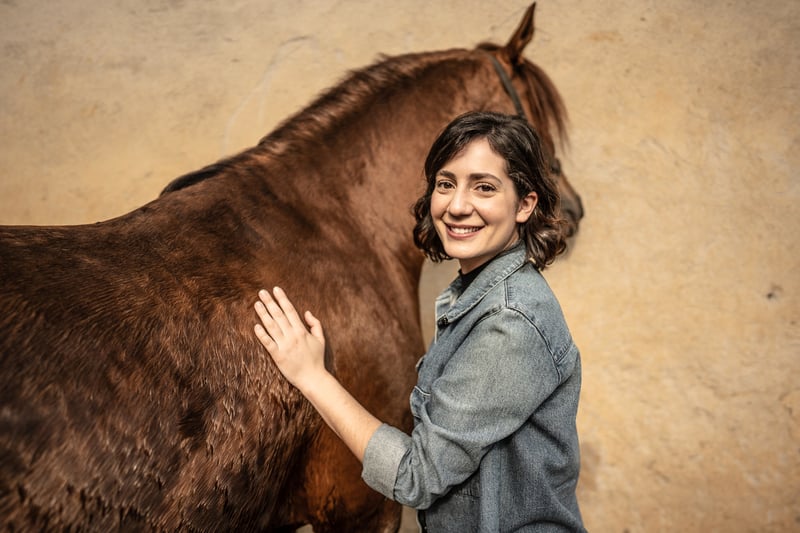
Massage therapy for horses helps stimulate the horse’s body to release endorphins, which aid in pain relief and help provide the horse with a sense of well-being. The massage can also directly affect the horse’s hypothalamus (the area of the brain that controls mood and other functions such as heart rate) to reduce pain and stress.
From a scientific point of view, equine massage therapy stimulates blood flow to different areas of the horse’s body to bring in more oxygen and nutrients to those areas. It’s also a successful technique for removing lactic acid buildup and helping to eliminate other metabolic waste from the body.
Massage therapy for horses can be used for everything from warming up a racehorse before their next race, relieving stress, or helping to stimulate healing after an injury. There is scientific proof that equine massage therapy is an extremely beneficial, valuable, and effective tool to help condition racehorses.
With that being said, all horses can benefit from having a massage, from older horses that need a bit of extra TLC to regular domestic horses.
Equine Sports Massage Therapy: How It Became What It Is Today
Although human massage has been a staple in medical treatment for thousands of years, it’s really only recently that massage therapy for horses has become mainstream. Historically speaking, equine massage is often said to have been around for at least 200 years, but it wasn’t until the so-called “father of equine sports massage”, Jack Meagher (1925–2005), developed a horse massage technique called “sports massage” in the 1950s for horses by applying his training and experience as a human physical therapist. The sports massage technique that he developed wasn’t just used on horses, it was also used on professional athletes in the Olympics and the NFL.
Jack Meagher becoming the first well-known equine massage therapist was somewhat of an accident. It’s said that his friend had a broken-down quarter horse that was barely able to walk and wanted Jack to try and see if he could use massage to help the animal. Through some investigation, Jack discovered that the horse was suffering from muscle spasms. After massaging, the horse apparently became “as frisky as a colt”. That result prompted Jack to invest his time in studying horse anatomy and practicing his massage techniques on other horses that needed help.
Jack’s main philosophy was that a “muscle is a muscle” and that if similar safe and effective massage techniques used for human athletes could be applied to help horse athletes, it should be done.
Jack's equine sports massage therapy uses a combined series of specific soft tissue applications based on anatomy, physiology, and muscular kinetics.
There are various massage techniques (the bullet list in the previous section lists the main ones), and sports massage uses these methods in different ways to improve an athlete’s performance.
The most commonly used equine massage therapy techniques are outlined in the table below:
|
Equine Sports Massage Therapy Technique |
Description |
|
Effleurage (stroking) |
|
|
Petrissage (kneading) |
|
|
Tapotement (rhythmic striking) |
|
|
Friction |
|
|
Vibration |
|
Benefits of Equine Massage Therapy
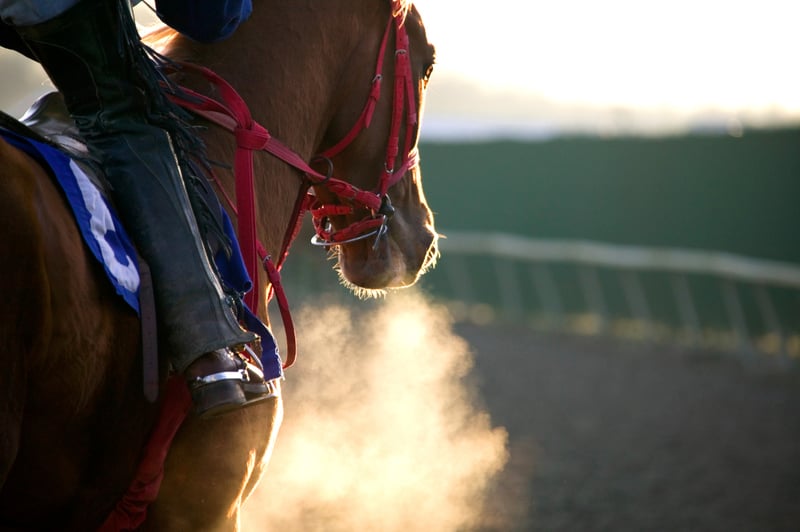
Horse owners will notice a wide range of benefits in their equines when they incorporate horse massage therapy as part of their equine’s overall wellness. These benefits include:
1. Pain Relief
By stimulating the muscles to increase blood flow and relieve tension, a horse can experience pain relief through equine massage therapy.
Massage reduces the activity of nociceptive pain receptors in your horse’s body, which are responsible for recognizing when the body experiences something dangerous, such as:
- Extreme temperature changes
- Unsafe objects
- Chemical compounds
Massaging the muscles reduces the sensitivity of these pain receptor pathways, allowing the horse to move more freely, for instance, while healing from an injury.
2. Stress Relief
Let’s face it, getting a massage just feels good, and it’s no different for your horse. Giving your horse a good massage helps them to relieve stress and put them in a good state of mind before performing in a race. This is because massaging releases endorphins, chemicals in the brain responsible for pain relief and a sense of well-being. Massaging a horse can also help calm nervous or unsure horses or horses that are in an unfamiliar environment or experiencing a stressful situation.
3. Improved Posture, Circulation, Coat, and Muscle Tone
Equine sports massage therapy also helps improve your horse’s posture blood flow, coat health, and muscle tone. When a Certified Equine Sports Massage Therapist touches your horse, these touches send messages to the horse’s nervous system. The nervous system communicates with your horse’s brain using electrical signals travelling throughout the body. Sometimes, professionals use a Golgi Tendon Apparatus to initiate an electrical message to the horse’s brain to address a muscle spasm. This electrical communication system can also be used as a way to re-educate muscles for efficient movement, allowing them to return to a correct posture for the horse.
4. Increased Flexibility and Range of Motion
The mechanical nature of equine massage therapy works to release tension from tight muscles, which not only increases muscle compliance but also removes stiffness and increases joint motion. This happens because the temperature of soft tissues is increased due to more blood flow, which improves tissue elasticity and breaks down adhesions that may have appeared in the muscles. It also reduces swelling by breaking down the buildup of white blood cells and removing waste products from the muscles.
Because muscles are now looser, the horse is more flexible and has a better range of motion in their joints.
5. Injury Prevention
Imagine a professional human athlete going straight into performing without stretching their muscles beforehand. If that image caused you to wince because you know that their risk of injury is significantly increased, then you now understand why making your horse race or perform in an event without stretching and massage is unheard of. Because equine massage loosens the muscles and allows easier movement and an increased range of movement of the joints, the chances of injury are decreased.
6. Provides Increased Benefits When Used Alongside Joint Supplements
The goals of equine massage therapy and joint supplements are similar: to provide a horse with the opportunity for easier, pain-free movement. Equine massage therapy is simply a technique that has a temporary benefit, while horse joint supplements, when given daily, facilitate positive changes to your horse’s joint structures.
For racehorses or other sport horses, TRI-ACTA H.A. is recommended. This is because the supplement, aside from containing two types of glucosamine and chondroitin (for overall joint health and mobility) and Methylsulfonylmethane (MSM, a natural anti-inflammatory), also includes hyaluronic acid. This essential ingredient improves the viscosity of the synovial fluid in your horse’s joints, allowing for easier and more pain-free movement.
When an equine joint supplement like TRI-ACTA H.A. and equine massage therapy are used together as part of your equine’s wellness and training plan, the benefits are significant. Our equine affiliates swear by our supplements as they have been developed with the highest quality ingredients and gold-standard manufacturing practices.
One of our equine affiliates, Josie Carroll, is a well-known Canadian horse racing trainer who in 2006 became the first female trainer to win Canada’s most prestigious race, the Queen’s Plate, with her horse Edenwold. She also went on to win the first jewel of the Canadian Triple Crown with the filly Inglorious in 2011. More recently, in 2020, Carroll won the Queen’s plate with Might Heart, who also went on to win a victory in the Prince of Wales Stakes 17 days later.
TRI-ACTA H.A. for Equine
Our maximum strength formula is perfect for horses that are ageing, experiencing arthritis and stiffness, are in training and competition, or under a heavy workload.
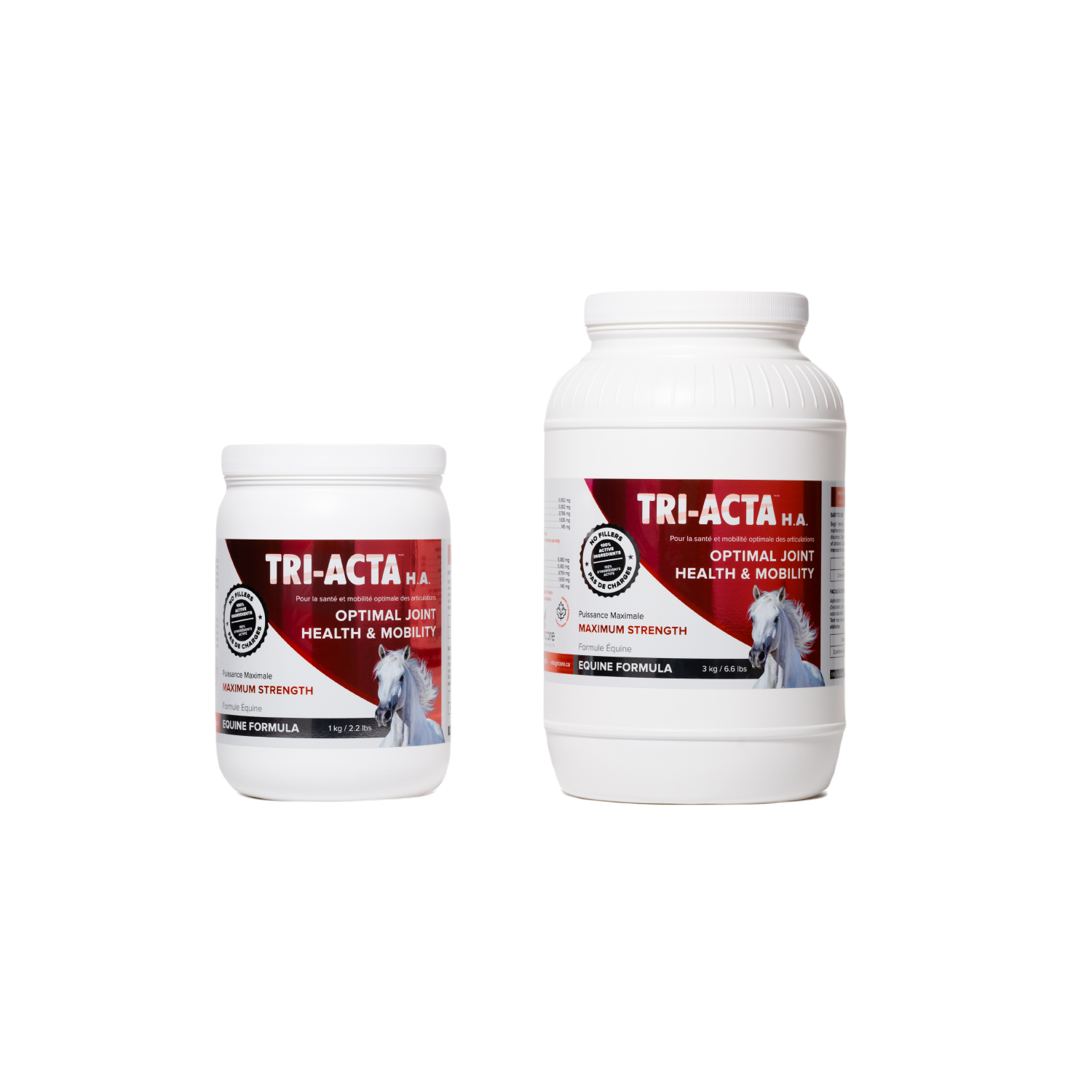
How to Prevent Injuries When Massaging Your Horse
Horses are powerful animals, and it requires a good amount of strength and knowledge of different techniques to massage a horse properly. This is why it's recommended to involve a Certified Equine Sports Massage Therapist in the process. However, there are ways that you can massage your horse at home to provide them with a bit of stress relief or to build your bond with them. But it’s important to keep in mind several considerations when massaging your horse to prevent injury to yourself. These considerations are as follows:
1. Stretch
Warming up your body before massaging your horse is important for injury prevention. Work your hands, wrists, and arms with slow, steady pressure. This gets the circulation moving in your hands and helps make your arms more flexible.
2. Use Your Bone Structure
It’s easy for your body to become fatigued and strained when massaging your horse. Instead of straining your muscles, it’s important to consider your bone structure and how you can use it as leverage during a massage.
For example, extending your arm with your elbow straight gives you the ability to exert direct pressure on the horse without entirely relying on the muscles in your arm or shoulder. Using your forearm is another way to relieve some pressure on your hands and wrists.
3. Direct Your Massage Strokes with Gravity
Take advantage of gravity when massaging your horse by allowing it to pull your arms downward as you perform massage strokes. Using gravity is also important when massaging your horse’s shoulders and legs, as you can use the force of gravity to help move your body downward instead of completely relying on your muscles to do so.
4. Take Advantage of Massage Tools
Equine massage tools are great for relieving potential strain while giving your horse an effective massage. A wide range of tools are available, but handheld tools reduce the strain on your arms and hands while still allowing you to effectively massage your horse.
Some tools can go for over $500, but one affordable tool that can be used with one hand is called the Equilibrium Therapy Heated Massage Mitt. This product is lightweight, portable, and battery-operated for ease of use. It’s also easy to clean and can be easily stored with the included storage and carry bag.
Additional Recovery Tips for Sport Horses
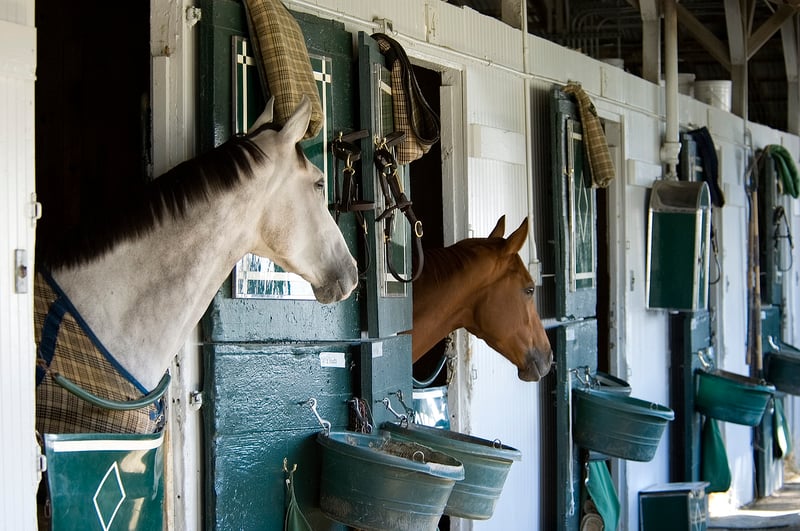
For sport horses, giving them a chance to recover after each performance is essential. Some essential tips for sport horse recovery include:
1. Turnout
Turnout is a practical tip for sport horse recovery. Simply getting your horse to walk around in a field helps to increase circulation, help clear the body of metabolites (end products of your horse’s metabolic process), reduce limb edema, and prevent stiffness. You can also use standing wraps to provide your horse with additional support.
2. Massage
Massage can be used as part of the conditioning process for your sport horse, but it can also be used to help relieve your horse’s strained and sore muscles after an event. Aside from relieving pain, massaging your horse also helps them relax and calm down after a competition when they are filled with adrenaline.
3. Rest
Allowing a horse to rest after a competition is important for their physical and mental health. The number of days of rest varies depending on the horse and the intensity of the work they perform.
Some experts suggest at least 24–48 hours, while others suggest up to 5 days. To determine the appropriate amount of rest that your horse needs, you need to consider the level of work they performed, their personality, and their tolerance for the work. Some horses will be keen to get back to regular training as soon as possible, while others may prefer to wait longer. Knowing your horse and understanding their body language is key in this process.
4. Boosting Recovery Effectiveness with Joint Supplements
Giving your horse a daily joint supplement like TRI-ACTA H.A. can do wonders for the effectiveness of their recovery time. By giving your horse’s joints the tools they need to stay strong and healthy, your horse will be able to recover faster, being race-ready sooner than before.
TRI-ACTA H.A. is a unique offering in the horse supplement market because it is made with 100% natural and therapeutic ingredients, is approved by Health Canada as a Veterinary Health Product, and follows Good Manufacturing Practices. The ingredients in TRI-ACTA H.A. are outlined in the table below:
|
TRI-ACTA H.A. Ingredient |
Benefit |
|
Glucosamine (HCl and Sulfate) |
|
|
MSM |
Natural anti-inflammatory that alleviates pain in aching or sore joints. |
|
Chondroitin Sulfate |
Works in tandem with glucosamine to fortify joint ligaments, muscles, and repair cartilage. |
|
Hyaluronic Acid |
Enhances synovial fluid viscosity in joints, promoting greater comfort and mobility for your horse. |
TRI-ACTA H.A. for Equine
Our maximum strength formula is perfect for horses that are ageing, experiencing arthritis and stiffness, are in training and competition, or under a heavy workload.

Summary
The importance of working your horse’s muscles prior to strenuous exercise cannot be overstated. Part of this process can include equine massage therapy, which helps a horse’s muscles become looser and more flexible before a race or competition.
Similar to human athletes, horses benefit from massage and stretching to prepare and recover from strenuous exercise, reducing the risk of injury and improving performance. Certified Equine Sports Massage Therapists apply their training to work on horses’ muscles and bodies safely, aiding injury prevention during performance work.
Massage therapy benefits all horses, aiding injury recovery, medical symptom relief, and regular conditioning for various roles like race horses or domestic companions.
Other benefits of equine massage therapy include:
- Pain and stress relief
- Improved posture, circulation, coat, and muscle tone
- Increased flexibility and injury prevention
- Synergistic effects with joint supplements for enhanced joint health
Combining equine massage with supplements like TRI-ACTA H.A. enhances joint health, aiding in easier and pain-free movement for horses.
Purchase TRI-ACTA H.A. online or learn where to buy at a store near you.
Newsletter Signup
Subscribe to our newsletter to receive the latest news and exclusive offers.
.jpg?height=2000&name=Cliick_Integricare-DISPLAY-REVISEDV2%20(1).jpg)
Proactive & Therapeutic Joint Supplements
When given daily, Integricare joint supplements recover bone and joint injuries faster and help prevent mobility injuries from happening in the first place.

